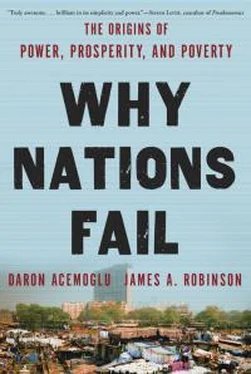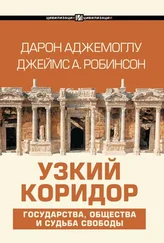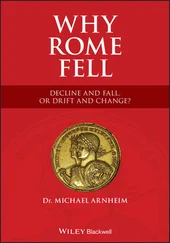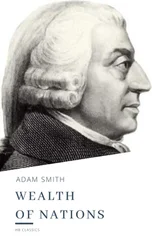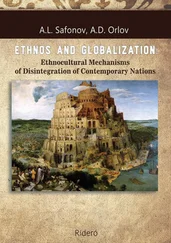One of the great tributaries of the River Congo is the Kasai. Rising in Angola, it heads north and merges with the Congo northeast of Kinshasa, the capital of the modern Democratic Republic of Congo. Though the Democratic Republic of Congo is poor compared with the rest of the world, there have always been significant differences in the prosperity of various groups within Congo. The Kasai is the boundary between two of these. Soon after passing into Congo along the western bank, you’ll find the Lele people; on the eastern bank are the Bushong (Map 6, this page). On the face of it there ought to be few differences between these two groups with regard to their prosperity. They are separated only by a river, which either can cross by boat. The two different tribes have a common origin and related languages. In addition, many of the things they build are similar in style, including their houses, clothes, and crafts.
Yet when the anthropologist Mary Douglas and the historian Jan Vansina studied these groups in the 1950s, they discovered some startling differences between them. As Douglas put it: “The Lele are poor, while the Bushong are rich … Everything that the Lele have or can do, the Bushong have more and can do better.” Simple explanations for this inequality are easy to come by. One difference, reminiscent of that between places in Peru that were or were not subject to the Potosí mita , is that the Lele produced for subsistence while the Bushong produced for exchange in the market. Douglas and Vansina also noted that the Lele used inferior technology. For instance, they did not use nets for hunting, even though these greatly improve productivity. Douglas argued, “[T]he absence of nets is consistent with a general Lele tendency not to invest time and labor in long-term equipment.”
There were also important distinctions in agricultural technologies and organization. The Bushong practiced a sophisticated form of mixed farming where five crops were planted in succession in a two-year system of rotation. They grew yams, sweet potatoes, manioc (cassava), and beans and gathered two and sometimes three maize harvests a year. The Lele had no such system and managed to reap only one annual harvest of maize.
There were also striking differences in law and order. The Lele were dispersed into fortified villages, which were constantly in conflict. Anyone traveling between two or even venturing into the forest to collect food was liable to be attacked or kidnapped. In the Bushong country, this rarely, if ever, happened.
What lay behind these differences in the patterns of production, agricultural technology, and prevalence of order? Obviously it was not geography that induced the Lele to use inferior hunting and agricultural technology. It was certainly not ignorance, because they knew about the tools used by the Bushong. An alternative explanation might be culture; could it be that the Lele had a culture that did not encourage them to invest in hunting nets and sturdier and better-built houses? But this does not seem to have been true, either. As with the people of Kongo, the Lele were very interested in purchasing guns, and Douglas even remarked that “their eager purchase of firearms … shows their culture does not restrict them to inferior techniques when these do not require long-term collaboration and effort.” So neither a cultural aversion to technology nor ignorance nor geography does a good job of explaining the greater prosperity of the Bushong relative to the Lele.
The reason for differences between these two peoples lies in the different political institutions that emerged in the lands of the Bushong and the Lele. We noted earlier that the Lele lived in fortified villages that were not part of a unified political structure. It was different on the other side of the Kasai. Around 1620 a political revolution took place led by a man called Shyaam, who forged the Kuba Kingdom, which we saw on Map 6, with the Bushong at its heart and with himself as king. Prior to this period, there were probably few differences between the Bushong and the Lele; the differences emerged as a consequence of the way Shyaam reorganized society to the east of the river. He built a state and a pyramid of political institutions. These were not just significantly more centralized than what came before but also involved highly elaborate structures. Shyaam and his successors created a bureaucracy to raise taxes and a legal system and police force to administer the law. Leaders were checked by councils, which they had to consult with before making decisions. There was even trial by jury, an apparently unique event in sub-Saharan Africa prior to European colonialism. Nevertheless, the centralized state that Shyaam constructed was a tool of extraction and highly absolutist. Nobody voted for him, and state policy was dictated from the top, not by popular participation.
This political revolution introducing state centralization and law and order in the Kuba country in turn led to an economic revolution. Agriculture was reorganized and new technologies were adopted to increase productivity. The crops that had previously been the staples were replaced by new, higher-yield ones from the Americas (in particular, maize, cassava, and chili peppers). The intense mixed-farming cycle was introduced at this time, and the amount of food produced per capita doubled. To adopt these crops and reorganize the agricultural cycle, more hands were needed in the fields. So the age of marriage was lowered to twenty, which brought men into the agricultural labor force at a younger age. The contrast with the Lele is stark. Their men tended to marry at thirty-five and only then worked in the fields. Until then, they dedicated their lives to fighting and raiding.
The connection between the political and economic revolution was simple. King Shyaam and those who supported him wanted to extract taxes and wealth from the Kuba, who had to produce a surplus above what they consumed themselves. While Shyaam and his men did not introduce inclusive institutions to the eastern bank of the Kasai, some amount of economic prosperity is intrinsic to extractive institutions that achieve some degree of state centralization and impose law and order. Encouraging economic activity was of course in the interest of Shyaam and his men, as otherwise there would have been nothing to extract. Just like Stalin, Shyaam created by command a set of institutions that would generate the wealth necessary to support this system. Compared to the utter absence of law and order that reigned on the other bank of the Kasai, this generated significant economic prosperity—even if much of it was likely extracted by Shyaam and his elites. But it was necessarily limited. Just as in the Soviet Union, there was no creative destruction in the Kuba Kingdom and no technological innovation after this initial change. This situation was more or less unaltered by the time the kingdom was first encountered by Belgian colonial officials in the late nineteenth century.
KING SHYAAM’S ACHIEVEMENT illustrates how some limited degree of economic success can be achieved through extractive institutions. Creating such growth requires a centralized state. To centralize the state, a political revolution is often necessary. Once Shyaam created this state, he could use its power to reorganize the economy and boost agricultural productivity, which he could then tax.
Why was it that the Bushong, and not the Lele, had a political revolution? Couldn’t the Lele have had their own King Shyaam? What Shyaam accomplished was an institutional innovation not tied in any deterministic way to geography, culture, or ignorance. The Lele could have had such a revolution and similarly transformed their institutions, but they didn’t. Perhaps this is for reasons that we do not understand, because of our limited knowledge of their society today. Most likely it is because of the contingent nature of history. The same contingency was probably at work when some of the societies in the Middle East twelve thousand years ago embarked upon an even more radical set of institutional innovations leading to settled societies and then to the domestication of plants and animals, as we discuss next.
Читать дальше
